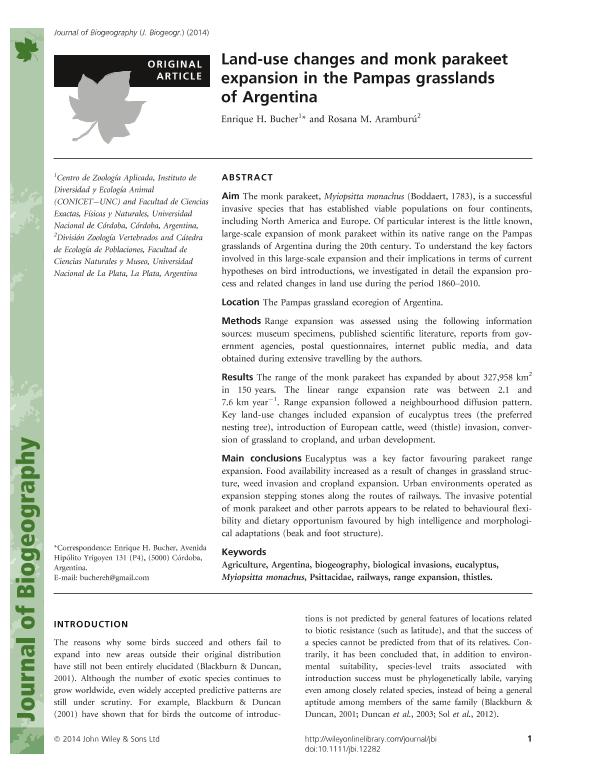Mostrar el registro sencillo del ítem
dc.contributor.author
Bucher, Enrique Hugo

dc.contributor.author
Aramburu, Rosana M.
dc.date.available
2016-11-04T16:21:36Z
dc.date.issued
2014-06
dc.identifier.citation
Bucher, Enrique Hugo; Aramburu , Rosana M.; Land-use changes and monk parakeet expansion in the Pampas grasslands of Argentina; Wiley Blackwell Publishing, Inc; Journal Of Biogeography; 41; 6; 6-2014; 1160-1170
dc.identifier.issn
0305-0270
dc.identifier.uri
http://hdl.handle.net/11336/7983
dc.description.abstract
Aim
The monk parakeet, Myiopsitta monachus (Boddaert, 1783), is a successful invasive species that has established viable populations on four continents, including North America and Europe. Of particular interest is the little known, large-scale expansion of monk parakeet within its native range on the Pampas grasslands of Argentina during the 20th century. To understand the key factors involved in this large-scale expansion and their implications in terms of current hypotheses on bird introductions, we investigated in detail the expansion process and related changes in land use during the period 1860?2010.
Location
The Pampas grassland ecoregion of Argentina.
Methods
Range expansion was assessed using the following information sources: museum specimens, published scientific literature, reports from government agencies, postal questionnaires, internet public media, and data obtained during extensive travelling by the authors.
Results
The range of the monk parakeet has expanded by about 327,958 km2 in 150 years. The linear range expansion rate was between 2.1 and 7.6 km year−1. Range expansion followed a neighbourhood diffusion pattern. Key land-use changes included expansion of eucalyptus trees (the preferred nesting tree), introduction of European cattle, weed (thistle) invasion, conversion of grassland to cropland, and urban development.
Main conclusions
Eucalyptus was a key factor favouring parakeet range expansion. Food availability increased as a result of changes in grassland structure, weed invasion and cropland expansion. Urban environments operated as expansion stepping stones along the routes of railways. The invasive potential of monk parakeet and other parrots appears to be related to behavioural flexibility and dietary opportunism favoured by high intelligence and morphological adaptations (beak and foot structure).
dc.format
application/pdf
dc.language.iso
eng
dc.publisher
Wiley Blackwell Publishing, Inc

dc.rights
info:eu-repo/semantics/openAccess
dc.rights.uri
https://creativecommons.org/licenses/by-nc-sa/2.5/ar/
dc.subject
Myiopsitta Monachus
dc.subject
Agriculture
dc.subject
Biogeography
dc.subject
Biological Invasions
dc.subject.classification
Ecología

dc.subject.classification
Ciencias Biológicas

dc.subject.classification
CIENCIAS NATURALES Y EXACTAS

dc.title
Land-use changes and monk parakeet expansion in the Pampas grasslands of Argentina
dc.type
info:eu-repo/semantics/article
dc.type
info:ar-repo/semantics/artículo
dc.type
info:eu-repo/semantics/publishedVersion
dc.date.updated
2016-11-02T18:12:15Z
dc.journal.volume
41
dc.journal.number
6
dc.journal.pagination
1160-1170
dc.journal.pais
Reino Unido

dc.journal.ciudad
Londres
dc.description.fil
Fil: Bucher, Enrique Hugo. Consejo Nacional de Investigaciones Cientificas y Tecnicas. Centro Cientifico Tecnologico Cordoba. Instituto de Diversidad y Ecologia Animal; Argentina. Universidad Nacional de Cordoba. Facultad de Cs.exactas Fisicas y Naturales. Centro de Zoologia Aplicada; Argentina
dc.description.fil
Fil: Aramburu , Rosana M.. Universidad Nacional de La Plata. Facultad de Ciencias Naturales y Museo; Argentina
dc.journal.title
Journal Of Biogeography

dc.relation.alternativeid
info:eu-repo/semantics/altIdentifier/url/http://onlinelibrary.wiley.com/doi/10.1111/jbi.12282/abstract
dc.relation.alternativeid
info:eu-repo/semantics/altIdentifier/doi/http://dx.doi.org/10.1111/jbi.12282
Archivos asociados
